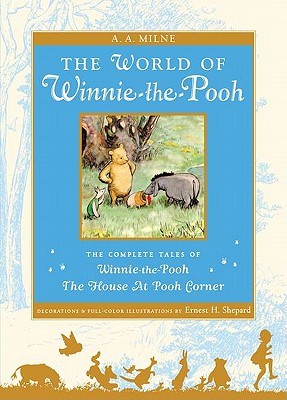Christopher Robin's toys, curated by the New York Public Library
Winnie-the-Pooh has never gone out of style, but lately he's seen a non-fiction renaissance--or rather, she has. Although the stuffed bear and his storybook counterpart are gentleman bears, the live bear behind them both was not. In fact, she was a female cub on sale at a Canadian train station, purchased by a sympathetic veterinarian on his way to to England, to serve in World War I. The vet, Harry Colebourn, brought the bear with him to England, naming her Winnie after his home city of Winnepeg. When he left for France, Winnie moved to the London Zoo, where she met Christopher Robin Milne.
The original Winnie's story has been adapted into not one but two very lovely non-fiction picture books this year:
Winnie: The True Story of the Bear Who Inspired Winnie-the-Pooh is written by long-time children's nonfiction author Sally M. Walker. It's the first book for illustrator Jonathan D. Voss, but his art has an appropriately mid-century feel, jovial, dynamic, and detailed. (He's also got a great online portfolio--I'm hoping we see more of him soon.)
Finding Winnie: The True Story of the World's Most Famous Bear has just come out this month. This one is written by Lindsay Mattick and illustrated by the prolific and beloved Sophie Blackall (of Ivy+Bean, Caldecott hopeful A Fine Dessert, and many more). Their version of Winnie's history is told as a bedtime story told to a little boy named Cole--fittingly enough, since Lindsay Mattick is Coleburn's real life great-granddaughter.
The third installation of Pooh nonfiction is a little different.
Kathryn Aalto's The Natural World of Winnie-the-Pooh is a lively exploration of the real model for Milne's Hundred Acre Wood, an English preserve called Ashdown Forest. Full color photos trade off with Milne's illustrations, building a bridge between Milne's ramblings and his creation. Although it's a book about children's books, the primary audience for Natural World is adults who still revel in their imaginary and familiar childhood hideaways, as well those who enjoy the natural beauties of the English countryside. Aalto is a first time book writer, but her chops as a landscape designer and historian serve her well. She's an excellent tour guide, and rather than stealing the wonder out of the Pooh books, she gives them new color and life. You can find Natural World in our Nature section.
Of course, there's nothing like the original. When you'd like to revisit Pooh and his friends in the Hundred Acre Wood (or visit them for the first time), come find them in the children's section. Whatever the facts of the matter may be, the stories are pretty great.






No comments:
Post a Comment